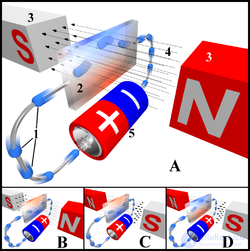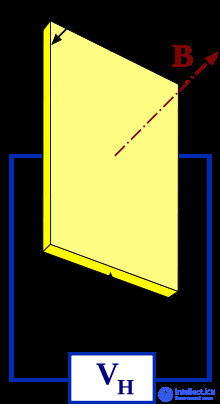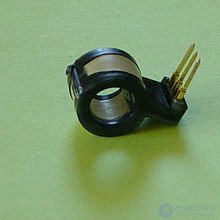Lecture

Effekt Holla - the phenomenon of the occurrence of transverse potential difference (also called Hall voltage ) when placing a conductor with a constant current in a magnetic field. Discovered by Edwin Hall in 1879 in thin gold plates.
In the simplest consideration, the Hall effect is as follows. Let through a conductive bar in a weak magnetic field  electric current flows under the influence of tension
electric current flows under the influence of tension  . The magnetic field will deflect the charge carriers to one of the sides of the beam from their movement along or against the electric field. In this case, the criterion of smallness [1] will be the condition that, in this case, charge carriers will not begin to move along the cycloid.
. The magnetic field will deflect the charge carriers to one of the sides of the beam from their movement along or against the electric field. In this case, the criterion of smallness [1] will be the condition that, in this case, charge carriers will not begin to move along the cycloid.

Thus, the Lorentz force will lead to the accumulation of a negative charge near one face of the bar, and a positive charge near the opposite. Charging will continue as long as the resulting electric field of charges  does not compensate for the magnetic component of the Lorentz force:
does not compensate for the magnetic component of the Lorentz force:

Electron velocity  can be expressed in terms of current density:
can be expressed in terms of current density:

Where  - concentration of charge carriers. Then
- concentration of charge carriers. Then

Coefficient  proportionality between
proportionality between  and
and  called the coefficient (or constant ) of the Hall . In this approximation, the sign of the Hall constant depends on the sign of charge carriers, which allows one to determine their type for a large number of metals. For some metals (for example, such as lead, zinc, iron, cobalt, tungsten), a positive sign is observed in strong fields
called the coefficient (or constant ) of the Hall . In this approximation, the sign of the Hall constant depends on the sign of charge carriers, which allows one to determine their type for a large number of metals. For some metals (for example, such as lead, zinc, iron, cobalt, tungsten), a positive sign is observed in strong fields  , which is explained in the semiclassical and quantum theories of a rigid body.
, which is explained in the semiclassical and quantum theories of a rigid body.
The occurrence of a voltage (electric field) in a sample perpendicular to the direction of the current through the sample, observed in the absence of an applied constant magnetic field (that is, a phenomenon completely similar to the Hall effect, but observed without an external constant magnetic field) is called the anomalous Hall effect .
A necessary condition for observing the anomalous Hall effect is a violation of invariance with respect to the time reversal in the system. For example, an abnormal Hall effect can be observed in samples with magnetization [2] .
In strong magnetic fields in a flat conductor (that is, in a quasi-two-dimensional electron gas), quantum effects begin to affect the system, which leads to the appearance of a quantum Hall effect: quantization of the Hall resistance. In even stronger magnetic fields, the fractional quantum Hall effect manifests itself, which is associated with a fundamental restructuring of the internal structure of a two-dimensional electron liquid.
In the absence of a magnetic field in non-magnetic conductors, a deviation of current carriers with opposite directions of spins in different directions perpendicular to the electric field can be observed. This phenomenon, called the spin Hall effect, was theoretically predicted by Dyakonov and Perel in 1971. They talk about external and internal spin effects. The first of these is associated with spin-dependent scattering, and the second with spin-orbit interaction.
Edwin Hall conducted experiments in the hope of detecting an increase in the resistance of the conductor in a magnetic field, but did not register it in weak fields. Also, it does not follow from the theory of metals Drude, calculations for which were cited above. However, with more rigorous calculations and in strong fields, the magnetoresistance is quite good.

The Hall effect, in some cases, allows us to determine the type of charge carriers (electron or hole) in a metal or semiconductor, which makes it a fairly good method for studying the properties of semiconductors.
Based on the Hall effect, Hall sensors work: devices that measure the magnetic field strength. Hall sensors are very common in brushless, or valve, electric motors (servomotors). The sensors are fixed directly on the stator of the engine and act as a DPR (rotor position sensor). DPR implements feedback on the position of the rotor, performs the same function as the collector in the collector DFT.
Also on the basis of the Hall effect work some types of ion jet engines.
Also, Hall-based sensors are widely used in smartphones as the physical basis of the electronic compass.
The official name is a position sensor on the Hall effect .
This is a Hall effect sensor, the essence of which lies in the fact that when a certain conductor with a constant current is placed in a magnetic field, a transverse potential difference arises in this conductor. Also calls Hall voltage.
The Hall sensor is very widespread in the automotive industry, it measures the camshaft position angle, on some cars the crankshaft position angle, on older cars it signaled the moment of sparking.

The Hall effect is that when current is passed through the terminals “a” of a semiconductor wafer placed in a magnet field, a voltage appears on the side terminals “b” .
Back in 1879, the American physicist E. Hall, who worked at the University of Baltimore, discovered an interesting phenomenon, the essence of which was as follows. If a rectangular semiconductor plate is placed in a magnetic field and electric current is applied to its narrow faces, a voltage will arise on the wide, facets of the plate, the value of which can be from tens of microvolts to hundreds of millivolts. However, the technical application of this effect was forcedly delayed by almost 75 years, until the time when industrial production of semiconductor films with the desired properties began.

Hall Sensor Device :
1 - permanent magnet;
2 - rotor blade;
3 - magnetic circuits;
4 - plastic case;
5 - microcircuit;
6 - conclusions.
Even later, with the development of microelectronics, it was possible to make a miniature sensor containing everything you need - a permanent magnet and a chip with a sensitive element. Such a device has a number of undeniable advantages.
Firstly - small size.
Secondly, and this is especially important, a change in the frequency of operation (in other words, engine speed) does not cause a shift in the measurement moment.
Third, the electrical signal from the sensor has, in the terminology of specialists, a rectangular shape: when turned on, it immediately dials a certain and constant value, and does not have the character of bursts. To control the electronics is a considerable plus.
The sensor has other advantages as well, but we will mention shortcomings. The main one is that which is inherent in any electronic circuit: the sensor is sensitive to electromagnetic interference arising in the power circuit (for the precautionary measures dictated by this circumstance, let us say below). In addition, the Hall sensor is more expensive than a magnetoelectric and theoretically less reliable because it contains an electronic circuit, but large-scale production and development of technology minimize these factors.
Works Hall sensor as follows. When the metal rotor blade passes through the gap, the magnetic flux is shunted and the induction on the microcircuit is zero. In this case, the signal at the output of the sensor relative to the “mass” has a high level, that is, it is almost equal to the supply voltage.

So you can check the performance of the Hall sensor :
1 - sensor;
2 - connector;
3 - resistor MLT-0.25 1.5 kΩ;
4 - LED or voltmeter (tester);
5 - battery 9 V.
Check the sensor is best with an oscilloscope. But with some caution, you can and more simple equipment, right on the machine.
The first thing to do is unplug the cable connector that matches the sensor. The most important condition that should be strictly observed: the ignition must be turned off! Non-observance of this condition is one of the main reasons for the failure of Hall sensors in operation. Now assemble the simple circuit shown in the figure. When the magnet passes the sensor, the LED should alternately light up and go out, indicating the presence of a signal.
Another important note: in no case do not check the sensor with a test lamp! That is how many devices are destroyed.
Comments
To leave a comment
Sensors
Terms: Sensors